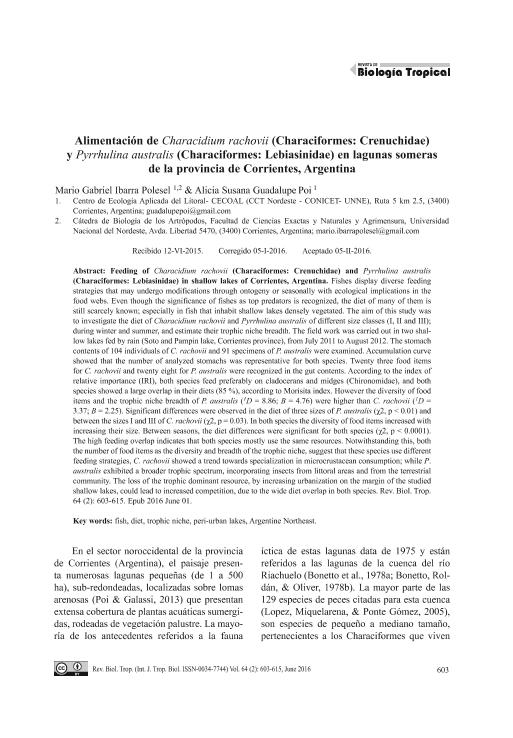Artículo
Alimentación de Characidium rachovii (Characiformes: Crenuchidae) y Pyrrhulina australis (Characiformes: Lebiasinidae) en lagunas someras de la provincia de Corrientes, Argentina
Título:
Feeding of Characidium rachovii (Characiformes: Crenuchidae) and Pyrrhulina australis (Characiformes: Lebiasinidae) in shallow lakes of Corrientes, Argentina
Fecha de publicación:
05/2016
Editorial:
Universidad de Costa Rica
Revista:
Revista de Biología Tropical
ISSN:
0034-7744
Idioma:
Español
Tipo de recurso:
Artículo publicado
Clasificación temática:
Resumen
Feeding of Characidium rachovii (Characiformes: Crenuchidae) and Pyrrhulina australis (Characiformes: Lebiasinidae) in shallow lakes of Corrientes, Argentina. Fishes display diverse feeding strategies that may undergo modifications through ontogeny or seasonally with ecological implications in the food webs. Even though the significance of fishes as top predators is recognized, the diet of many of them is still scarcely known; especially in fish that inhabit shallow lakes densely vegetated. The aim of this study was to investigate the diet of Characidium rachovii and Pyrrhulina australis of different sizes classes (I, II and III); during winter and summer and estimate their trophic niche breadth. The field work was carried out in two shallow lakes fed by rain (Soto and Pampin lake, Corrientes province), from July 2011 to August 2012. The stomach contents of 104 individuals of C. rachovii and 91 specimens of P. australis were examined. Accumulation curve showed that the number of analyzed stomachs was representative for both species. Twenty three food items for C. rachovii and twenty eight for P. australis were recognized in the gut contents. According to the index of relative importance (IRI), both species feed preferably on cladocerans and midges (Chironomidae), and both species showed a large overlap in their diets (85%) according to Morisita index. However the diversity of food items and the trophic niche breadth of P. australis (1D=8.86; B=4.76) were higher than C. rachovii (1D=3.37; B=2.25). Significant differences were observed in the diet of three sizes of P. australis (χ2, p<0.01) and between the sizes I and III of C. rachovii (χ2, p=0.03). In both species the diversity of food items increased with increasing their size. Between seasons, the differences in diet were significant for both species (χ2, p <0.0001). The high feeding overlap indicates that both species mostly use the same resources. Notwithstanding this, both the number of food items as the diversity and breadth of the trophic niche, suggest that these species use different feeding strategies, C. rachovii showed a trend towards specialization in microcrustacean?s consumption; while P. australis exhibited a broader trophic spectrum, incorporating insects from littoral areas and from the terrestrial community. The loss of the trophic dominant resource by increases of urbanization on the margin of the studied shallow lakes could lead to increase competition due to the wide overlap in the diet of both species.
Archivos asociados
Licencia
Identificadores
Colecciones
Articulos(CECOAL)
Articulos de CENTRO DE ECOLOGIA APLICADA DEL LITORAL (I)
Articulos de CENTRO DE ECOLOGIA APLICADA DEL LITORAL (I)
Citación
Ibarra Polesel, Mario Gabriel; Poi, Alicia Susana G.; Alimentación de Characidium rachovii (Characiformes: Crenuchidae) y Pyrrhulina australis (Characiformes: Lebiasinidae) en lagunas someras de la provincia de Corrientes, Argentina; Universidad de Costa Rica; Revista de Biología Tropical; 64; 2; 5-2016; 603-615
Compartir
Altmétricas




